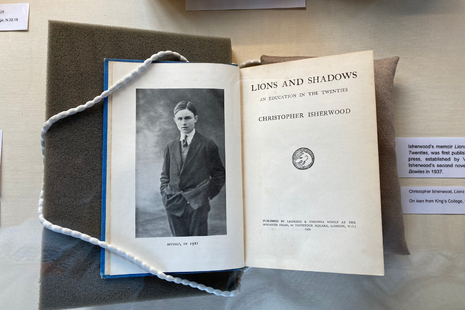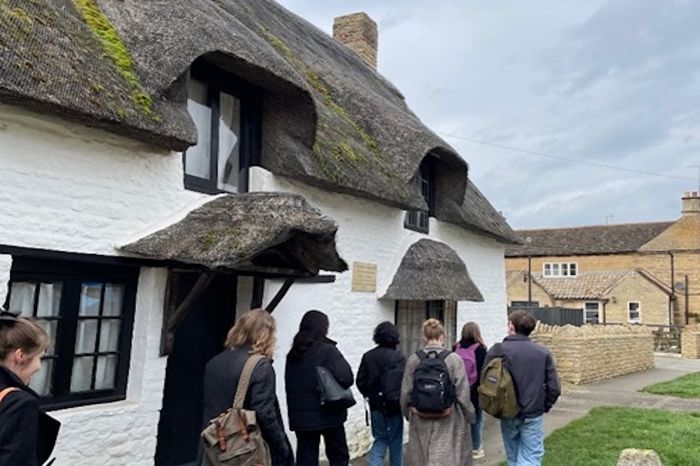An establishing shot: Christopher Isherwood in Cambridge
Eve Connor and Joe Short visit the Isherwood exhibition space and reflect on his lasting cultural legacy

Before the modern hillside residence, and three hundred and ten days of sunshine a year in Santa Monica, Christopher Isherwood was an undergraduate at Corpus Christi. Lions and Shadows, his 1938 novel, describes the “macabre” university city as a site of “perpetual darkness” – apt, perhaps, in this grey, post-Euros summer. But for all its fine weather, even Santa Monica was at first reproached in a letter to E.M. Forster as a “thin, noisy tone-film of fast cars [and] advertisements”; Isherwood would “stay for the present” or else join “an ambulance corps” (in fact, he stayed for the rest of his life.) But freedom is insisted upon: a self-described “foreigner by temperament”, Isherwood lived in motion, ejecting himself from Cambridge without a degree by writing gibberish on his exam papers. He was always moving on. He touched more lives than can be counted. The worlds he visited never forgot him.
“His 1938 novel describes the ‘macabre’ university city as a site of ‘perpetual darkness’ – apt, perhaps, in this grey, post-Euros summer”
That first “macabre” city is no different. To mark the centenary of his matriculation, the Parker Library’s ‘Isherwood in Cambridge’ exhibition pleasingly synthesised eclectic displays from Isherwood’s student days with more contemporary-inspired work. As curators, Eliza Haughton-Shaw and Conrad Steel faced the not-so-simple question of how to present an exhibition that the subject “would almost certainly have viewed with […] surprise and contempt”. The result astounds in its capacity to capture Isherwood’s writhing, acerbic essence or, as Professor John David Rhodes trippingly termed it, his “bemused sophomoric scepticism”. The letter to Forster is there, and the exam paper, the debut novel, and the supervision essay, as well as typed drafts of The Montmere Stories, a malicious series of satires by Isherwood and his friend, Edward Upward, against Cambridge’s detested “poshocracy”. The gleeful wallop of their typewriters resounds from a photograph of Isherwood’s first-year room, until the exhibit label admits that his “preferred haunt” was actually downstairs with Upton, and we are hoodwinked again. Who was Isherwood in Cambridge? Our answer has fled around another corner.
“The result astounds in its capacity to capture Isherwood’s writhing, acerbic essence”
At the McCrum Lecture Theatre, in conversation with Eliza Haughton-Shaw about her new biography Christopher Isherwood Inside Out, Katherine Bucknell sketched her decades-long pursuit of these corners. As the director of The Christopher Isherwood Foundation, the editor of his diaries, and a firm friend of Isherwood’s life partner, the artist Don Bachardy, the longevity of Bucknell’s care for her subject shines through as she speaks. She pinpoints Isherwood reading Frank Harrison’s two-volume biography of Oscar Wilde, in a room very much like Edward Upton’s, as the moment that germinated his enduring need for freedom. Wilde had refused to flee abroad to escape the charge of gross indecency launched against him: five years later, he was dead. A queer man in 1920s Cambridge, Isherwood demanded more than the cruelty of entrenched history had allotted him. He resolved, unlike Wilde, to survive.
“Isherwood’s multiplicity is the fruit of that survival – of living”
Isherwood’s multiplicity is the fruit of that survival – of living. How radical and important that the questions don’t stop with “who was Isherwood in Cambridge?”. We can ask, what about Berlin? Who was Isherwood in Greece? Portugal? China? Who did he become in California? Bucknell found the cover image for Christopher Isherwood: Inside Out on an unprinted contact sheet of photographs taken by one of Isherwood’s partners (Bill Caskey) and preserved by another (Don Bachardy). The photo was sent to Bucknell’s publisher at Chatto, Clara Farmer, and transferred to The Huntington Library where the curator Sarah Francis located the negatives. Stephen Parker resituated the arresting image of Isherwood holding a wooden frame onto the front cover. So many hands and frames led to the book on the table, a chain linking through space and time. Isherwood did not shed his different selves and worlds as he moved, but accumulated them. His ultimate goal, as Bucknell understands it, was to keep the conversation going.
Most teasing is a photograph in another book, the first edition of Lions and Shadows. An adolescent Isherwood greets us from the inside cover, the sharp focus on his face blurring as his hands find his trouser pockets and upend his jacket. The caption reads: ‘MYSELF, IN 1921’. His mouth seems to creep upwards and a ghost of amusement touches what we had first read as solemnity; the brow deepens. Once more, Isherwood is on the move. And, already, he is changing. Go on, Christopher!
 News / Caius mourns its tree-mendous loss23 December 2025
News / Caius mourns its tree-mendous loss23 December 2025 News / Clare Hall spent over £500k opposing busway 24 December 2025
News / Clare Hall spent over £500k opposing busway 24 December 2025 Comment / The ‘class’ of Cambridge24 December 2025
Comment / The ‘class’ of Cambridge24 December 2025 Comment / Yes, I’m brown – but I have more important things to say22 December 2025
Comment / Yes, I’m brown – but I have more important things to say22 December 2025 Interviews / Politics, your own way: Tilly Middlehurst on speaking out21 December 2025
Interviews / Politics, your own way: Tilly Middlehurst on speaking out21 December 2025









